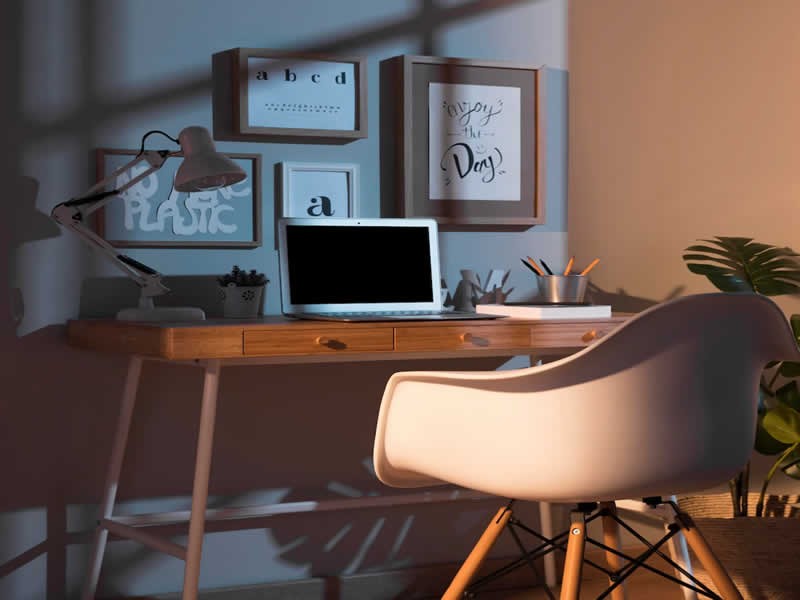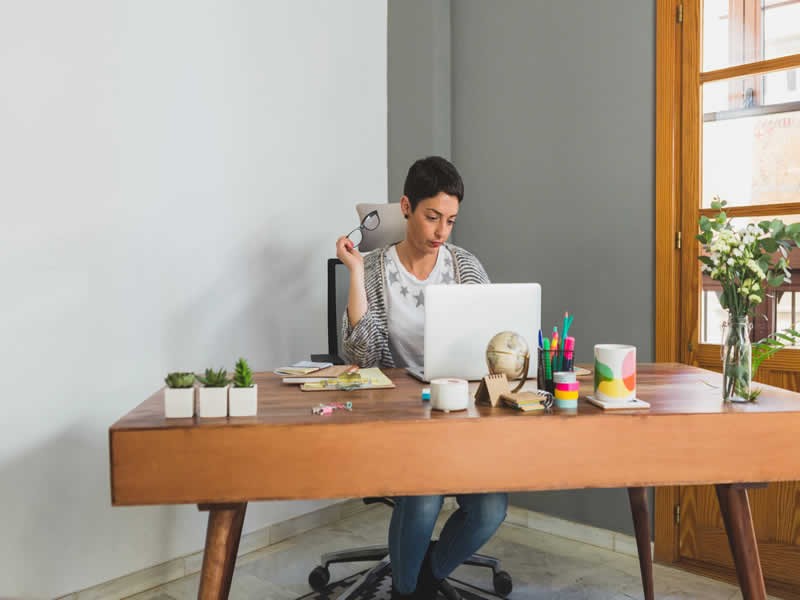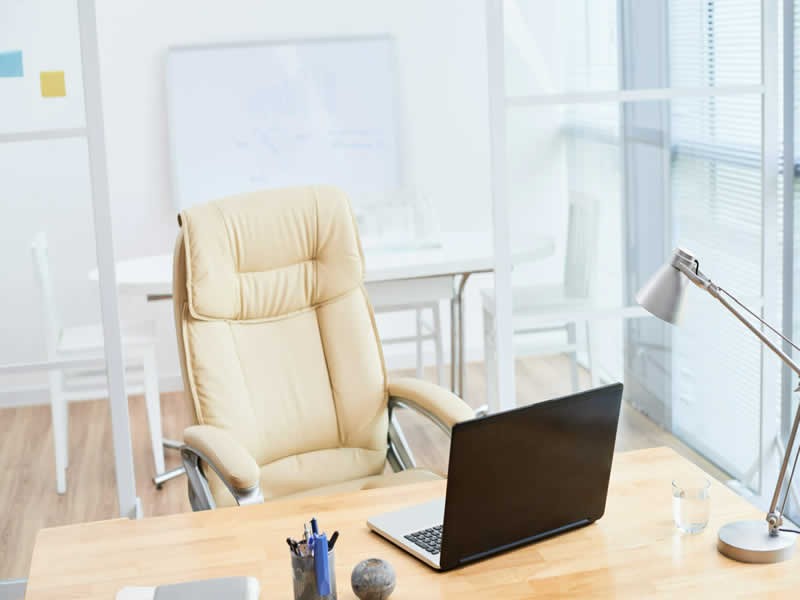Insight Blog
Agility’s perspectives on transforming the employee's experience throughout remote transformation using connected enterprise tools.
16 minutes reading time
(3271 words)
The average size of home office: A Perfect Workspace
A home office can be set up in various sizes and but what is the average size of home office?
When you're working from home, and square footage is at a premium, it might be difficult to find the ideal layout for your office. In this age of remote work, it's important to have a designated space in your home that can be easily set up for home working. Still, you should also consider how your furniture pieces fit together, how they fold away at the end of the day, and what sort of space you want your home office to be.
Everything from the chair to the desk to the storage solutions in your home office should be carefully selected, and the dimensions of these crucial furniture pieces should be considered. Working from home can be the ideal setting for stimulating your creativity if planned and carried out properly.
So what is the average size of home office read on for guidelines on what to consider and how much room you'll need for a modest home office.
The importance of setting up a dedicated space at home
Nobody likes having to reposition their items constantly. Avoid this by establishing a separate workspace for remote work, be it a complete room or a desk in the corner of an existing room.
Having a dedicated space at home can be important for several reasons. Firstly, it can help establish a sense of separation between work and personal life, which can be beneficial for maintaining work-life balance. Additionally, a dedicated space can help with productivity and organization by providing a specific area for work tasks and materials. This can make it easier to focus and stay on task. Furthermore, having a dedicated space can also help with mental health and well-being by creating a sense of stability and routine.
Finally, it can help you to maintain your privacy and avoid distractions from family members and other household activities.
By having a specific place to do work, you may more easily draw a line between your workday and your personal life, making it simpler to "clock out" when the workday is done. The important question is what should be the size of the home office?
What is a good home office size?
There is no standard size for a home office. Some people convert a spare bedroom into an office, while others do so with a desk in the corridor or a table in a bay window. As a result, the typical size of a home office now varies widely.
Home offices range in size from 50 square feet (a nook or corner of a room rarely used) to 150 square feet (a former guest bedroom). Before deciding on what pieces of furniture and home office organization strategies to implement, take careful stock of the available space by measuring its dimensions.
The size of a home office will depend on the individual's needs and the space available in the home.
A good home office size will typically be large enough to accommodate a desk, chair, and other necessary office equipment, such as a computer, printer, and filing cabinet. It should also have enough room to move around comfortably, and ideally, have natural light next to a window.
Ultimately, the most important aspect of a home office is that it is functional and comfortable for the person using it. So, as long as the space is comfortable to work in, and has everything you need to do your job, it is considered a good home office size.
What if you do not have enough space for a home office setup?
It's fairly uncommon to lack sufficient financial resources while attempting to put a concept for a business into action. That's why it makes more sense to maximize your resources by working from home. Despite this, you'll likely require adequate workplace space under these circumstances.
A balcony, a connecting hallway, or even two adjoining rooms can serve as a makeshift office if you lack dedicated space in your home.
You can use different methods if the available space in your House is limited. That way, the primary office may house the most often used tools, while the secondary office can house the others.
If you do not have enough space for a dedicated home office setup, here are several options you can consider:
- Convert a spare room: If you have a spare room that is not currently being used, you can convert it into a home office. This will give you the most space and privacy, but it may not be possible for everyone.
- Use a corner or alcove: If you have a corner or alcove that is not being used, you can set up a small desk and chair to create a mini home office.
- Use a closet: If you have a spare closet, you can clear it out and set up a small desk and chair inside. This will give you a private space to work in, but it may not be the most comfortable option.
- Use a multi-purpose furniture: Consider using furniture that has multiple functions, such as a fold-down desk or a wall-mounted table. This will allow you to have a workspace when you need it and tuck it away when you don't.
- Create a portable office: If you don't have a spare room or corner, you can create a portable office by using a laptop and a comfortable chair. This setup can be moved around the house as needed, so you can work wherever you feel most comfortable.
The key is to be creative and make the most of what you have.
In addition, if your office is adjacent to a set of stairs, you can turn the landing between the two rooms into a shortcut to the main entrance. One more time, this would demonstrate your managerial prowess while also improving the guest experience. Using the area beneath the steps as extra storage is also a great idea.
How to improve the light in your home office?
Consider the role that lighting will play in the layout of your desk when planning a home office for a compact space.
If you have a tiny workspace, natural light is very precious. Here are 5 tips to improving the lighting in your home office:
- Use natural light: Make sure to take advantage of natural light by positioning your desk near a window. This will not only improve the light in your home office, but it will also boost your mood and productivity.
- Add task lighting: In addition to natural light, consider adding task lighting, such as a desk lamp or a floor lamp, to brighten up specific areas of your home office.
- Use light-colored paint: Painting your home office walls in light colors can help to reflect light and brighten up the space.
- Add mirrors: Mirrors can help to reflect light and make a small space appear larger and brighter.
- Use a light dimmer: A light dimmer switch allows you to adjust the brightness of your lighting to suit the task at hand. This can be especially helpful if you work at different times of the day or need different levels of light depending on the task.
Having your home office next to or near a window will allow for plenty of natural light, making the space feel less confining and more conducive to productive work.
Consider purchasing an adjustable arm to place a task light at your desk at an angle. You can adjust the beam to create either a wide wash of illumination or a narrow beam of illumination. It's important to consider how much light you'll need to illuminate your workspace before deciding on a lamp's height.
Besides natural light and regular lamps, neon signs are also emerging ways. You can design your text and graphics based on your preference, and choose different neon colors according to the décor of your home, which can add a stylish touch. BPS.com Neon signs also balance the atmosphere of home and work, so that you can feel comfortable while working.
Possible ways to use the extra space in the home office
Finding a few spare feet for a home office is challenging enough, but making the most of that area is an entirely different ballgame.
Even if you've managed to carve out a tiny piece of your home for use as an office, you'll still need to figure out what to do with the room's awkward corners if you want to make the most of the space you have.
That dull, confined, dark nook of your home office is ripe with unrealized promise, yet it's rarely given the attention it deserves. Finding what serves you best is all that remains.
Use it as a guest room
Many people find it practical to use their spare bedroom as a combination guest room and home office, and the lonely corner can come to the rescue again in this situation. It's simple to install a Murphy bed or a modern daybed in the space formerly occupied by the home office, and in many cases, the bed entirely disappears when it's not in use.
This is an excellent option if you routinely have guests over the weekend or use an extra bedroom.
Make it a conversation zone
We get that not everyone wants to spend days poring over literature and that some people would rather unwind with a warm discussion with someone they care about. An overlooked nook in the home office could be the perfect place to relax in peace.
Adding a few club chairs and a coffee table can create a comfortable conversation area and more seating for your customers.
Space for reading books
You don't care about having enough bookcase room in your home office. Then take it a step further by transforming that uninteresting nook into a luxurious reading sanctuary.
A comfy chair, a table light (or a modern floor lamp), and a modest shelf to display your book collection will do. In the home office, you may now relax with a book and a drink once you've finished up on the computer.
Using it for storage
When setting up a home office, storage space is more of a priority than a desk and chair. While some of us may require a place to store our data, others may simply desire some extra storage for their stationary supplies.
No matter what you're trying to accomplish in your home office, making use of the space in the corners is wise. Wall-mounted cabinets take up no floor area, and it's simple to install corner shelves in a room. Home offices can benefit from decorative touches like open floating shelves in a corner to add visual space and visual interest.
Use plants for decoration
Adding an indoor plant to that vacant space is a simple solution, and as such, it may seem too inconsequential.
But how many of you even have a little greenery in your home office to liven things up? Aside from their aesthetic value, plants can help you live a longer, healthier, and happier life by removing hazardous chemicals from the air in your home office.
Nature can significantly impact workplace productivity, so don't discount its importance.
How to select the right desk for your home office?
Make sure there is room for your legs and your laptop or computer at the desk you choose, and consider the chair you plan on using.
The ideal height for a desk in a home office is 29 to 30 inches, while there is greater leeway in the workable area. There is no pressing need for your desk to take up a lot of space because most of us are accustomed to working from home and a flexible working life, which means we pack up our offices at the end of the day and utilize laptops or tablets.
Investing in a height-adjustable, compact desk will allow you to use your space better. Consider alternatives like laptop desks, console desks, foldable workstations, and L-shaped corner offices that give you more freedom. Standing workstations are also rising since they are more comfortable and take up less room than traditional desks. The widespread adoption of electric standing workstations is the most notable alteration. Most Scandinavian countries have long had a strong "care after your staff" ethos; therefore, these are commonplace.
Start by figuring out how much space you need for your computer, mouse, keypad, and landline phone. From there, you can determine the area for various peripherals and have enough room to open a binder and write.
How to pick the right chair size for your home office?
First things first, it's crucial to have a high-quality chair at your office. Finding the perfect chair is tricky since you want it to be functional and fashionable. That involves finding a happy medium between an attractive seat that doesn't offer any ergonomic support and a large, clumsy, and aesthetically uncomfortable office-style chair that is healthy for your posture. A great chair combines fashionable design with sturdy construction.
Consider your seating needs in relation to the room's intended use. Do you need to roll around the room, or would you rather kick your feet up and relax? Prioritizing what's most important will help you determine how much room you have for a desk and chair.
A properly sized ergonomic home office chair will have a deep enough seat so the user may lean back on the backrest and will also leave two to four inches of room between the back of the knees and the seat.
Adjusting the office chair to a person's unique dimensions is necessary (height, weight). Around 10 to 12 inches of clearance is recommended between the desk and chair in an office setting. The best chairs allow the user to move in all directions: forwards, backward, laterally, and vertically.
This sort of sedentary behavior is known as "active sitting." Your core muscles will strengthen as you learn to sit actively, and you'll notice an immediate improvement in your posture, a lessening of stiffness in your joints, and a rise in your level of focus and concentration.
Making your home office a nice place to work
Your home office should be somewhere you enjoy spending time at the end of the day. Create a more comfortable and inviting environment by decorating and customizing your workspace. Plants help to perk up space.
Decorating using photos of friends, family, and memorable moments is a terrific way to make your space seem more like home. Prints of your favorite video game, paintings by your favorite artist, or artwork you created yourself will provide the creative finishing touch to your setup.
How can you make your home office look bigger?
Your home office might provide the impression of more space by employing some of these methods.
When decorating an office, using lower-profile furniture items is a terrific method to give the impression of taller ceilings and more space. Modern low-slung furniture is ideal for expanding the feeling of height and width in an office and facilitating the entry of natural light because it does not hinder the sightlines to windows.
If you want your office to look bigger, paint the molding, walls, and ceiling the same color and strategically use color. Painting the walls and molding the same color will help everything flow more smoothly than if the colors were varied.
Since this causes a lengthened effect, it gives the impression that your workplace has higher ceilings and greater square footage than it does.
How much does it cost to set up a home office?
This is the most common question asked by remote workers. After the Coronavirus outbreak and the conflict in Ukraine, inflation skyrocketed in recent years, and we were all affected.
When we go shopping, it is distressing to see the prices on the shelves of nearly everything. Nonetheless, having a home office allows us to deduct a portion of our income and cut our normal transportation costs.
Accordingly, it is worthwhile to invest a suitable sum of money.
A desk, computer, chair, and other technological equipment, as well as access to the internet and a software subscription, are standard workplace necessities. Expenses in this category also fluctuate with factors including material, quality, and manufacturer.
You may get the office ready for no money down or at most $500 if you have the drive and enthusiasm to get it ready.
You can have extra things, and the budget can be between $2,000-$6,000. It's up to you to make a reasonable call for your situation and wallet.
How to create a work/life balance in a home office setup?
Don't set up shop in the living room or kitchen. These spaces are commonly used right after work (making it harder to switch gears from work to home), and, as common areas, they are rife with distractions, especially in shared residences.
Having a dedicated space to shut the door and leave your work worries behind is essential if you work from home.
Closed-off rooms are preferable, but not everyone has access to them. If that's the case, consider all the spare rooms you have that may be converted into offices. No huge room is needed to house your home office, provided you use your imagination.
Start by setting the rules
Shared living situations with roommates, spouses, or children necessitate setting ground rules for where and when each person may get their job done. Tell them when they expect to find you relaxing and when they should avoid interrupting you.
Setting the ground rules early on will go a long way toward maintaining productivity and fostering a healthy work/life balance, even if it may be challenging initially, especially with young children.
Do not forget to take breaks
One of the keys to success in any endeavor is the ability to step away from work for a little while, relax and refocus our attention so that we may return to it with renewed vigor and enthusiasm. If you work from home, you need to be more mindful of when to take breaks than in a traditional office setting.
Plan your breaks according to the clock or the progress you've made. Even if you can only spare a few minutes, taking breaks frequently throughout the day will help keep your energy and productivity levels consistent.
Personalizing the home office setup
It's only natural to want to make some touches to your office that reflect your personality, given how much time you spend there. Use personal items like photographs, artwork, and mementos to convey your message. This will make it feel more like your home office is yours and less like a shared room in the house.
You can show your past achievements and trophies. Let your office reflect who you are by including meaningful objects, photos, and mementos from your life.
While it's great to express yourself creatively and personally in your job, going to extremes might be counterproductive. Likewise, they will make your work area look cluttered.
Wrapping up
Now that you've read this article, you know how big a home office you need. The space can then be utilized to serve your needs best. Office space can be organized and partitioned as needed. The dimensions mentioned above will help you set up the perfect home office for your remote work.
Categories
Blog
(2626)
Business Management
(321)
Employee Engagement
(211)
Digital Transformation
(175)
Intranets
(120)
Growth
(119)
Remote Work
(61)
Sales
(48)
Collaboration
(37)
Culture
(29)
Project management
(29)
Customer Experience
(26)
Knowledge Management
(21)
Leadership
(20)
Comparisons
(6)
News
(1)
Ready to learn more? 👍
One platform to optimize, manage and track all of your teams. Your new digital workplace is a click away. 🚀
Free for 14 days, no credit card required.















